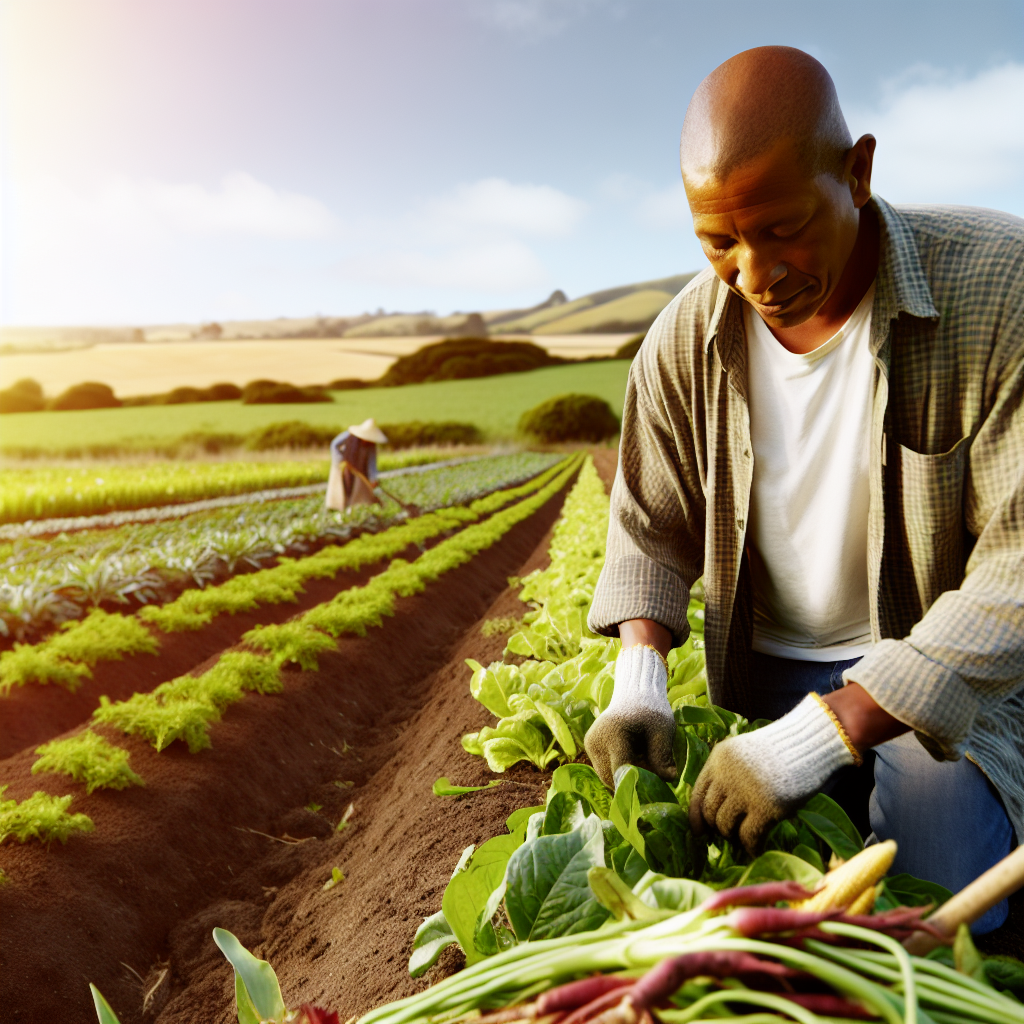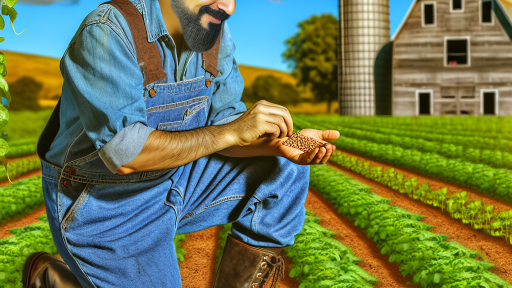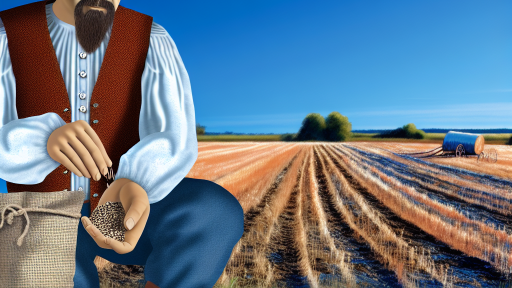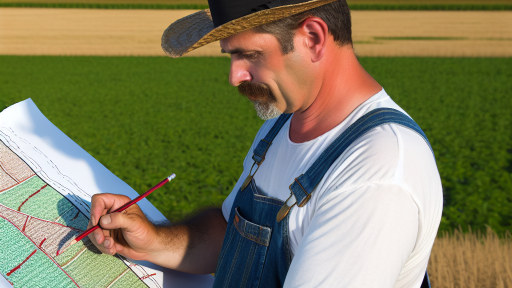Introduction to Sustainable Farming and Its Importance
Defining Sustainable Farming
Sustainable farming promotes agricultural practices that respect the environment.
It involves crop rotation, reduced chemical use, and biodiversity preservation.
Additionally, it seeks to maintain soil health for future generations.
Benefits to the Environment
This farming method helps mitigate climate change effects.
It reduces carbon footprints through organic practices.
Moreover, it enhances wildlife habitats by preserving natural ecosystems.
Economic Advantages
Sustainable farming can lead to cost savings for farmers.
Utilizing local resources reduces dependency on chemical inputs.
Additionally, it opens markets for organic and sustainably sourced products.
Social and Community Impact
This approach fosters community involvement in agriculture.
Local food systems support small businesses and farms.
Furthermore, it promotes food security and access to healthy options.
Global Importance
Sustainable farming addresses global food security challenges.
It emphasizes the need to feed a growing population sustainably.
Ultimately, it contributes to a resilient agricultural system worldwide.
Transform Your Agribusiness
Unlock your farm's potential with expert advice tailored to your needs. Get actionable steps that drive real results.
Get StartedCriteria for Selecting Edible Plants for Sustainability
Climatic Adaptability
Choose plants that thrive in local climatic conditions.
This adaptability ensures better growth and yield.
Consider seasonal temperature variations when selecting crops.
Additionally, native plants often require less water and care.
Soil Compatibility
Assess the soil type for your farming area.
Crops need to match the nutrient composition of the soil.
Highlight plants that enhance soil health through natural processes.
Legumes, for example, fix nitrogen in the soil.
Water Efficiency
Opt for crops that require minimal water consumption.
Drought-resistant plants help conserve water resources.
Incorporating such plants promotes sustainable farming practices.
Furthermore, practice efficient irrigation techniques to improve water usage.
Pest Resistance
Select plants that have natural pest-repelling qualities.
Such plants reduce the need for chemical pesticides.
For instance, marigolds can deter harmful insects.
Incorporating diversity in plant species increases resilience against pests.
Harvesting and Yield
Consider the potential yields of chosen plants.
High-yielding crops maximize land use efficiency.
Additionally, select plants that provide multiple harvests per season.
These choices improve both food security and economic viability.
Market Demand
Evaluate local market needs when selecting plants.
Growing in-demand crops can lead to higher profit margins.
This approach ensures that your effort aligns with consumer preferences.
Furthermore, consider trends towards organic and locally sourced foods.
Showcase Your Farming Business
Publish your professional farming services profile on our blog for a one-time fee of $200 and reach a dedicated audience of farmers and agribusiness owners.
Publish Your ProfileNutritional Value
Prioritize crops that offer significant nutritional benefits.
Edible plants should contribute essential vitamins and minerals.
Incorporating a variety of nutrient-rich plants supports community health.
For example, leafy greens and root vegetables are excellent choices.
Top Nutrient-Dense Plants for Sustainable Farming Practices
Importance of Nutrient Density
Nutrient-dense plants are essential for sustainable farming.
They provide significant health benefits to consumers.
Additionally, these plants improve soil health through biodiversity.
Leafy Greens
Leafy greens are among the most nutrient-rich plants available.
Spinach, kale, and Swiss chard all offer high levels of vitamins.
These greens thrive in various soil conditions, promoting sustainability.
Spinach
Spinach is incredibly versatile in recipes.
It grows quickly, making it an excellent choice for farmers.
Kale
Kale is a powerhouse of nutrients and antioxidants.
It can tolerate poor soil and withstand colder climates.
Legumes
Legumes enrich the soil by fixing nitrogen naturally.
They contribute to better crop rotation strategies.
Common legumes include beans, peas, and lentils.
Beans
Beans are rich in protein and fiber.
They can be intercropped with cereals to maximize yield.
Lentils
Lentils require less water compared to other crops.
This quality makes them suitable for sustainable farming.
Herbs
Herbs are valuable for both culinary and medicinal uses.
Basil, cilantro, and rosemary are popular choices among farmers.
Basil
Basil thrives in warm temperatures and rich, well-drained soil.
It enhances various dishes with its aromatic flavor.
Cilantro
Cilantro grows quickly and can be harvested multiple times.
Its culinary versatility keeps it in high demand.
Root Vegetables
Root vegetables are crucial for a balanced diet.
Carrots, beets, and radishes are nutrient-dense options.
Carrots
Carrots provide essential vitamins and minerals.
They are easy to grow and store well for long periods.
Beets
Beets are high in fiber and beneficial nutrients.
They improve soil health when they decompose.
Fruits
Fruits offer natural sugars and vital nutrients.
Examples include berries, apples, and pears.
Berries
Berries are high in antioxidants and low in calories.
They thrive in diverse climates and enrich soil health.
Apples
Apple trees require less maintenance than many other fruit trees.
They produce large quantities of food annually.
Uncover the Details: Beginner’s Guide to Mushroom Farming on Small Farms
Showcase Your Farming Business
Publish your professional farming services profile on our blog for a one-time fee of $200 and reach a dedicated audience of farmers and agribusiness owners.
Publish Your ProfilePerennial vs. Annual Edible Crops: Pros and Cons
Understanding Perennial Crops
Perennial crops live for more than two years.
They return every season without replanting.
This aspect promotes stability in the ecosystem.
Moreover, they often require less water and fertilizer.
Examples include asparagus and rhubarb.
Advantages of Perennial Crops
First, perennial crops improve soil health.
They maintain organic matter and prevent erosion.
This helps retain moisture and nutrients in the soil.
Additionally, they attract beneficial insects.
Thus, they can minimize pest issues naturally.
Challenges of Perennial Crops
However, establishing perennial crops can take time.
They may not yield significant harvests in the beginning.
This can be a drawback for new farmers.
Also, certain species might be susceptible to disease.
Exploring Annual Crops
Annual crops complete their life cycle in one year.
Farmers plant them each season for new harvests.
This strategy allows for diverse crop rotations.
Common examples include tomatoes and corn.
Benefits of Annual Crops
Annual crops often provide quicker returns.
This type of farming can maximize productivity.
Furthermore, yearly planting allows for crop diversity.
Farmers can respond to changing market demands effectively.
Disadvantages of Annual Crops
Annual crops can lead to soil degradation.
Constant tilling disrupts soil structure and health.
This practice increases the need for fertilizers and water.
Additionally, they can attract specific pests consistently.
See Related Content: Maximizing Crop Yields With Container Gardening
Incorporating Nitrogen-Fixing Plants Into the Farming System
The Role of Nitrogen-Fixing Plants
Nitrogen-fixing plants play a crucial role in sustainable farming.
They help improve soil fertility naturally.
This process enhances crop yield and reduces chemical fertilizer usage.
Types of Nitrogen-Fixing Plants
Several types of nitrogen-fixing plants can benefit your farm.
- Legumes, such as peas and beans, are popular choices.
- Alfalfa and clover are excellent for pasture systems.
- Some tree species, like black locust, also fix nitrogen.
Benefits of Incorporating Nitrogen-Fixing Plants
Incorporating these plants offers multiple advantages.
They enhance soil health by adding organic matter.
These plants also help prevent soil erosion effectively.
Furthermore, they support beneficial microorganisms in the soil.
Strategies for Planting Nitrogen-Fixing Species
Utilizing nitrogen-fixing plants requires strategic planning.
Plant them in rotation with cash crops for optimal benefits.
Intercropping legumes with staple crops fosters better growth.
Additionally, cover cropping can enhance soil conditions.
Challenges of Using Nitrogen-Fixing Plants
While beneficial, challenges may arise from using these plants.
Showcase Your Farming Business
Publish your professional farming services profile on our blog for a one-time fee of $200 and reach a dedicated audience of farmers and agribusiness owners.
Publish Your ProfileSome species can become invasive if not managed correctly.
Moreover, farmers may need to learn new management practices.
Understanding local climate conditions is essential for success.
Best Practices for Successful Integration
To ensure successful integration, consider best practices.
- Conduct soil tests to determine nitrogen needs.
- Choose suitable nitrogen-fixing plants for your ecosystem.
- Monitor plant growth and make adjustments as necessary.
Nitrogen-fixing plants can significantly boost sustainable farming practices.
Uncover the Details: DIY Mushroom Growing Kits for Small-Scale Farmers

Best Practices for Growing and Harvesting Edible Plants Sustainably
Choosing the Right Plants
Opt for native plants that thrive in your local climate.
These plants often require less maintenance and resources.
Diverse plant selections enhance biodiversity in your garden.
Consider plants that provide multiple harvests throughout the year.
Soil Management Techniques
Focus on building healthy soil through composting.
Compost enriches the soil and encourages beneficial microorganisms.
Implement crop rotation to prevent nutrient depletion.
Use cover crops to maintain soil health and prevent erosion.
Water Conservation Strategies
Implement rainwater harvesting systems to collect water efficiently.
Utilize drip irrigation for targeted watering and reduced waste.
Monitor weather patterns to optimize irrigation schedules.
Mulch your plants to retain moisture and suppress weeds.
Minimizing Pest Issues
Encourage beneficial insects by planting a variety of flowers.
Use companion planting to naturally deter pests.
Regularly inspect plants for signs of infestations.
Implement organic pest control methods when necessary.
Harvesting Techniques
Harvest crops at their peak for the best flavor and nutrition.
Use clean and sharp tools to minimize plant damage during harvesting.
Be mindful of the environment while harvesting to protect surrounding plants.
Store harvested produce properly to extend its shelf life.
Explore Further: Climate Control Strategies for Mushroom Cultivation
Case Studies of Successful Sustainable Edible Plant Farms
Green Haven Farms
Green Haven Farms cultivates a diverse range of heirloom vegetables.
This farm utilizes organic methods to enhance soil health.
Moreover, they practice crop rotation to maintain nutrient levels.
As a result, their yields consistently exceed local averages.
Sunny Acres Organic Farm
They engage customers by offering seasonal produce subscriptions.
In addition, their composting initiatives reduce waste significantly.
This practice enriches their soil and minimizes fertilizer needs.
Heritage Gardens
Heritage Gardens specializes in agroforestry systems.
They integrate edible trees with traditional crops.
This approach creates a multi-layered ecosystem that boosts biodiversity.
Consequently, they enjoy increased resilience against pests and diseases.
EcoSprout Farms
EcoSprout Farms employs innovative vertical farming techniques.
Showcase Your Farming Business
Publish your professional farming services profile on our blog for a one-time fee of $200 and reach a dedicated audience of farmers and agribusiness owners.
Publish Your ProfileThis design maximizes space use in urban environments.
Furthermore, they utilize renewable energy sources to reduce costs.
The results demonstrate lower water usage compared to traditional farming methods.
Willow Creek Farm
Willow Creek Farm emphasizes regenerative agriculture practices.
They focus on building soil health through cover cropping.
This strategy enhances carbon sequestration and reduces erosion.
As a result, they observe significant increases in yield over time.
Future Trends in Sustainable Edible Plant Farming
Technological Innovations
Technology continues to reshape sustainable farming practices.
Farmers are using data analytics for crop management.
Additionally, drones assist in monitoring crop health.
New software improves yield prediction and resource allocation.
Moreover, vertical farming technology reduces land usage significantly.
Agroecological Approaches
Agroecology embraces natural processes to enhance farming efficiency.
This method aids in pest management using beneficial insects.
It also promotes crop diversity and soil regeneration.
Cultivating native plants supports local ecosystems effectively.
In turn, this practice improves resilience against climate fluctuations.
Consumer Demand for Local Foods
There is a growing preference for locally sourced produce.
Consumers increasingly value food transparency and sustainability.
Farm-to-table initiatives strengthen local economies.
Additionally, community-supported agriculture fosters closer producer-consumer relationships.
This shift encourages more farms to adopt sustainable practices.
Regenerative Agriculture
Regenerative agriculture focuses on restoring soil health.
This practice involves no-till farming and cover cropping.
It enhances biodiversity and carbon sequestration in the soil.
Farmers adopting these methods often report higher yields over time.
Furthermore, regenerative practices can improve water retention.
Vertical and Urban Farming
Urban farming is becoming a viable solution for food deserts.
Vertical farms utilize limited space to maximize production.
These farms often use hydroponics and aquaponics for efficient growth.
As a result, they reduce transportation costs and emissions.
Moreover, urban farming improves access to fresh produce in cities.
Climate-Resilient Crops
Developing climate-resilient crop varieties is essential.
These crops can withstand extreme weather conditions.
Farmers are experimenting with genetic modification for resilience.
Furthermore, traditional breeding methods yield strong, adaptable plants.
This ensures food security amidst climate challenges.




